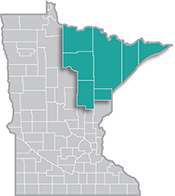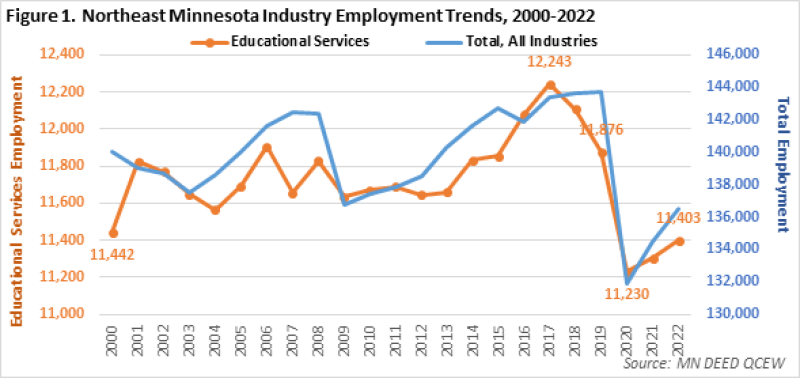 Home to the state's second-largest metro, the Northeast Region has a strong industrial sector, tied largely to the area's abundant natural resources.
Home to the state's second-largest metro, the Northeast Region has a strong industrial sector, tied largely to the area's abundant natural resources.
Most of the manufacturing base centers on mining and forest products industries. More than half of the sector's employment is in paper and machinery manufacturing.
Want the freshest data delivered by email? Subscribe to our regional newsletters.
8/22/2023 9:00:00 AM
Carson Gorecki
School is about to start back up for the year. Just as students are planning what to wear for their first day back, so are their teachers, administrators, and other staff that make our education system work. The Educational Services industry sector consists of employees at public, private, or non-profit schools, colleges & universities, and training centers. In Northeast Minnesota, the Educational Services sector had 11,403 jobs across 264 establishments in 2022, good for 8.3% of regional employment, making it the 4th largest employing sector. The bulk of the sector's jobs were at Local (7,164) and State (2,379) Government institutions. Private school employment made up the remaining 1,860 jobs (see Table 1).
| Table 1. Northeast Minnesota Educational Services Employment and Wages by Ownership, 2022 | |||
|---|---|---|---|
| Ownership | Employment – Number of Jobs | Number of Establishments | Average Annual Wage |
| Total, All Ownerships | 11,403 | 264 | $51,844 |
| State Government | 2,379 | 12 | $63,440 |
| Local Government | 7,164 | 158 | $51,220 |
| Private | 1,860 | 94 | $39,728 |
| Source: MN DEED QCEW | |||
Since 2000, the total number of Educational Services jobs in the region remained between 11,230 and 12,243 jobs. Despite fluctuations over the past two decades, both the high (at 12,243 jobs in 2017) and low points (at 11,230 jobs in 2020) of employment occurred recently. Prior to 2016, the range was even more stable, spanning less than 500 jobs. Sector employment fell -4% over the pandemic period, despite all the pressure on schools and their employees. That's a smaller decline than the average for all industries in the region (-5%). However Educational Services employment has rebounded more slowly than the average for all industries. The sector remained about 475 jobs below the pre-pandemic level and has regained only 170 jobs since 2020 (see Figure 1).

Educational Services wages were slightly higher than the regional average until 2017, then tracked closely with the overall average until 2020, when Educational Services wages fell below the average across the total of all industries. Educational Services wages grew more slowly than the total of all industries, and the discrepancy in wage growth expanded even more recently. Since 2020, Educational Services wages growth (+3.9%) was less than half that of all industries (+10.5%) (see Figure 2).

Part of the slow employment growth in Educational Services over the past couple years may have to do with the inability to fill open positions. In 2022, there were an estimated 767 job vacancies in Educational Services in Northeast Minnesota, according to the Job Vacancy Survey. That is the highest number of vacancies in the region since 2015, and the second highest since 2001.
The greatest needs according to the survey appeared to be not for the core or full-time teaching positions as much for the part-time and support positions. Tutors and Short-Term Substitute Teachers each had vacancy rates exceeding 50%, indicating one vacancy for every two filled jobs. The regional vacancy rate for all industries, by comparison, sat at 9.2%. Preschool Teachers (90 vacancies) and Teaching Assistants (145 vacancies) had the highest number of openings, also indicating high demand (see Table 2).
| Table 2. Job Vacancy Details for Selected Educational Occupations in Northeast Minnesota, 2022 | ||||
|---|---|---|---|---|
| Occupation | Number of Vacancies | Vacancy Rate | Median Wage Offer | Percent Part-time |
| Total, All Occupations | 12,388 | 9.2% | $17.36 | 34% |
| Educational Instruction & Library Occupations | 507 | 6.3% | $17.89 | 45% |
| Teaching Assistants, exc. Postsecondary | 145 | 8.1% | $14.02 | 81% |
| Preschool Teachers, exc. Special Education | 90 | 20.1% | $15.64 | 13% |
| Substitute Teachers, Short-Term | 76 | 58.5% | $19.74 | 76% |
| Secondary School Teachers, exc. Special Ed. & Career/Tech Ed. | 44 | 4.0% | $23.75 | 18% |
| Postsecondary Teachers | 39 | n/a | $24.63 | 3% |
| Tutors | 31 | 51.7% | $16.95 | 97% |
| Special Education Teachers, Secondary School | 20 | 8.0% | $21.76 | 0% |
| Special Education Teachers, Kindergarten & Elementary | 9 | 5.3% | $22.70 | 11% |
| Elementary School Teachers, exc. Special Education | 8 | 0.8% | $22.32 | 0% |
| Source: DEED Job Vacancy Survey | ||||
The four Educational occupations mentioned in the previous paragraph as having the highest number of vacancies or vacancy rates are also the four occupations in the Education occupation group with the lowest median wage offers. The $14.02 median hourly wage offer for Teaching Assistants is the lowest by more than $1.60, followed by Preschool Teachers and Tutors, which are both under the median for all occupations in the region. With the exception of Preschool Teachers, each of the four occupations had high shares of vacancies listed as part-time, reflecting the nature of many support positions in the Education field.
Compared to most industries, Educational Services employment has remained relatively resilient over the past several years. Yet the slower than average wage growth is something to be watched as competition for workers remains high and certain positions remain difficult to fill.
Contact Carson Gorecki, Labor Market Analyst, at carson.gorecki@state.mn.us.